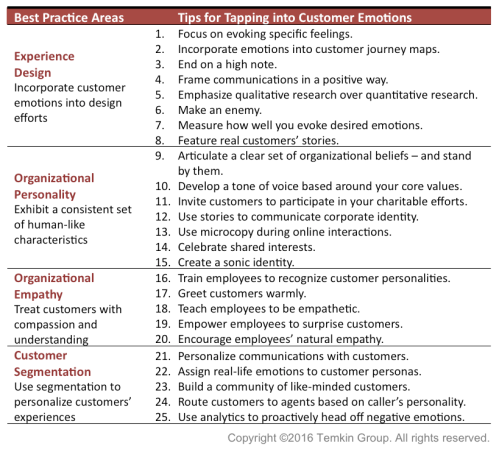Did you know that customers who feel adoring after an experience are more than 11 times as likely to buy more from a company than customers who feel angry? And customers who feel appreciative are more than 5 times as likely to trust a company than those who feel agitated?
That’s because how customers feel about an interaction has a significant impact on their loyalty to a company. So let’s talk about emotions.
Despite the importance of customer emotions, they are all too often neglected (or outright ignored) inside of companies. As a result of this negligence, consumers give their providers very low emotion scores in our Temkin Experience Ratings.
It’s time to start talking about emotions. To help spur this dialogue, we introduced a new vocabulary that we call the Five A’s of an Emotional Response.

Every time a customer interacts with you, they feel one of these A’s:
- Angry: Customers feel wronged by the interaction and will look for opportunities to tell other people (a.k.a. vent) about the situation. They will try to stay away from the organization.
- Agitated: Customers didn’t enjoy the interaction and will think twice about doing business with the organization in the future.
- Ambivalent: Customers had no significant emotional response and will remain as loyal as they were before the interaction.
- Appreciative: Customers feel that the organization outperformed their expectations and are more inclined to do business with the organization in the future.
- Adoring: Customers feel like company fully met their needs and will look for opportunities to tell other people about the situation. They will try to interact more with the organization in the future.
If you’re still wondering why you might want to talk about the Five A’s, here’s some data that will hopefully entice you to increase your emotion vocabulary. We analyzed the loyalty of 10,000 U.S. consumers based on the Five A’s of their emotional response to interactions across 20 industries – more than 100,000 overall interactions in total.

As you can see above, the Five A’s aren’t just a set of words, they’re a strong indication of the loyalty of your customers. Compared with those who feel “angry,” customers who feel “adoring” are more than 11 times as likely to buy more, 17 times as likely to recommend the company, 9 times as likely to try new offerings, 6 times as likely to forgive the company if it makes a mistake, and 10 times as likely to trust the company.
If you are not talking about emotion, then you’re not being purposeful about customer loyalty. Here are some ways that you can start using the Five A’s:
- Training. If you teach all employees this scale, then your organization will have a common vocabulary for discussing customer reactions. This framework will help trainees gauge how customers would likely respond to situations and discuss what they could do to improve the customer’s ultimate emotional response.
- Coaching. Supervisors can ask their employees a very simple question after an interaction: “How do you think the customer felt about the call?” This can work for any employee that interacts with customers: phone reps, retail salespeople, cashiers, insurance agents, bank tellers, etc.
- Designing. When you are creating a new experience (product, process, interaction, etc.), get feedback from customers about how they feel. Internally, you can have discussions like… “Most of the customers were ambivalent, but if we make this change then I think we can make most of them appreciative and even a few of them will be adoring.”
- Tracking customer emotions. Every time employees interact with a customer or make a decision, they can give themselves a score based on what they believe is (or will be) the customers’ most likely emotional response to their action:
- Angry (-3)
- Agitated (-1)
- Ambivalent (0)
- Appreciative (+1)
- Adoring (+3)
The total across these interactions and decisions represents a customer delight score. Employees can calculate this score on a regular basis (daily, weekly) and track how well they are doing over time.
Having an emotion vocabulary will hopefully get you to focus more about this critical topic. And if you just start talking about emotion, you will help stimulate employees’ natural empathy. So… start talking about emotion!
The bottom line: Talk about making customers adoring, not angry.
 If you are only going to read only one thing about customer experience, then this report is it. It’s the blueprint for building a customer-centric organization… and it’s free.
If you are only going to read only one thing about customer experience, then this report is it. It’s the blueprint for building a customer-centric organization… and it’s free.











 Tomorrow I will join millions of Americans in celebrating Thanksgiving. Many of us will spend the day with our families devouring turkey, stuffing, and other savory dishes while watching football games. It’s also a great time to actually give thanks.
Tomorrow I will join millions of Americans in celebrating Thanksgiving. Many of us will spend the day with our families devouring turkey, stuffing, and other savory dishes while watching football games. It’s also a great time to actually give thanks.





 18″ x 24″ poster: in
18″ x 24″ poster: in 


